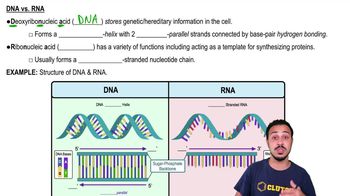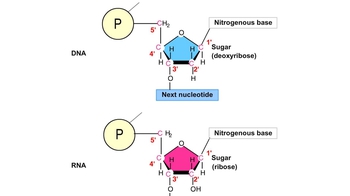Table of contents
- 1. Introduction to Biology2h 42m
- 2. Chemistry3h 40m
- 3. Water1h 26m
- 4. Biomolecules2h 23m
- 5. Cell Components2h 26m
- 6. The Membrane2h 31m
- 7. Energy and Metabolism2h 0m
- 8. Respiration2h 40m
- 9. Photosynthesis2h 49m
- 10. Cell Signaling59m
- 11. Cell Division2h 47m
- 12. Meiosis2h 0m
- 13. Mendelian Genetics4h 44m
- Introduction to Mendel's Experiments7m
- Genotype vs. Phenotype17m
- Punnett Squares13m
- Mendel's Experiments26m
- Mendel's Laws18m
- Monohybrid Crosses19m
- Test Crosses14m
- Dihybrid Crosses20m
- Punnett Square Probability26m
- Incomplete Dominance vs. Codominance20m
- Epistasis7m
- Non-Mendelian Genetics12m
- Pedigrees6m
- Autosomal Inheritance21m
- Sex-Linked Inheritance43m
- X-Inactivation9m
- 14. DNA Synthesis2h 27m
- 15. Gene Expression3h 20m
- 16. Regulation of Expression3h 31m
- Introduction to Regulation of Gene Expression13m
- Prokaryotic Gene Regulation via Operons27m
- The Lac Operon21m
- Glucose's Impact on Lac Operon25m
- The Trp Operon20m
- Review of the Lac Operon & Trp Operon11m
- Introduction to Eukaryotic Gene Regulation9m
- Eukaryotic Chromatin Modifications16m
- Eukaryotic Transcriptional Control22m
- Eukaryotic Post-Transcriptional Regulation28m
- Eukaryotic Post-Translational Regulation13m
- 17. Viruses37m
- 18. Biotechnology2h 58m
- 19. Genomics17m
- 20. Development1h 5m
- 21. Evolution3h 1m
- 22. Evolution of Populations3h 52m
- 23. Speciation1h 37m
- 24. History of Life on Earth2h 6m
- 25. Phylogeny2h 31m
- 26. Prokaryotes4h 59m
- 27. Protists1h 12m
- 28. Plants1h 22m
- 29. Fungi36m
- 30. Overview of Animals34m
- 31. Invertebrates1h 2m
- 32. Vertebrates50m
- 33. Plant Anatomy1h 3m
- 34. Vascular Plant Transport1h 2m
- 35. Soil37m
- 36. Plant Reproduction47m
- 37. Plant Sensation and Response1h 9m
- 38. Animal Form and Function1h 19m
- 39. Digestive System1h 10m
- 40. Circulatory System1h 57m
- 41. Immune System1h 12m
- 42. Osmoregulation and Excretion50m
- 43. Endocrine System1h 4m
- 44. Animal Reproduction1h 2m
- 45. Nervous System1h 55m
- 46. Sensory Systems46m
- 47. Muscle Systems23m
- 48. Ecology3h 11m
- Introduction to Ecology20m
- Biogeography14m
- Earth's Climate Patterns50m
- Introduction to Terrestrial Biomes10m
- Terrestrial Biomes: Near Equator13m
- Terrestrial Biomes: Temperate Regions10m
- Terrestrial Biomes: Northern Regions15m
- Introduction to Aquatic Biomes27m
- Freshwater Aquatic Biomes14m
- Marine Aquatic Biomes13m
- 49. Animal Behavior28m
- 50. Population Ecology3h 41m
- Introduction to Population Ecology28m
- Population Sampling Methods23m
- Life History12m
- Population Demography17m
- Factors Limiting Population Growth14m
- Introduction to Population Growth Models22m
- Linear Population Growth6m
- Exponential Population Growth29m
- Logistic Population Growth32m
- r/K Selection10m
- The Human Population22m
- 51. Community Ecology2h 46m
- Introduction to Community Ecology2m
- Introduction to Community Interactions9m
- Community Interactions: Competition (-/-)38m
- Community Interactions: Exploitation (+/-)23m
- Community Interactions: Mutualism (+/+) & Commensalism (+/0)9m
- Community Structure35m
- Community Dynamics26m
- Geographic Impact on Communities21m
- 52. Ecosystems2h 36m
- 53. Conservation Biology24m
4. Biomolecules
Nucleic Acids
Problem 7`
Textbook Question
Which of the following pairs of base sequences could form a short stretch of a normal double helix of DNA?
a. 5′-AGCT-3′ with 5′-TCGA-3′
b. 5′-GCGC-3′ with 5′-TATA-3′
c. 5′-ATGC-3′ with 5′-GCAT-3′
d. All of these pairs are correct.
 Verified step by step guidance
Verified step by step guidance1
Understand the basic principle of DNA base pairing: In a DNA double helix, adenine (A) pairs with thymine (T), and cytosine (C) pairs with guanine (G).
Examine option a: 5′-AGCT-3′ with 5′-TCGA-3′. Check if each base pairs correctly according to the base pairing rules: A with T, G with C, C with G, and T with A.
Examine option b: 5′-GCGC-3′ with 5′-TATA-3′. Check if each base pairs correctly: G with C, C with G, G with C, and C with G. Notice that T does not pair with G, and A does not pair with C.
Examine option c: 5′-ATGC-3′ with 5′-GCAT-3′. Check if each base pairs correctly: A with T, T with A, G with C, and C with G.
Determine which pair(s) follow the correct base pairing rules and conclude whether one or more pairs can form a normal double helix of DNA.
 Verified video answer for a similar problem:
Verified video answer for a similar problem:This video solution was recommended by our tutors as helpful for the problem above
Video duration:
1mPlay a video:
Was this helpful?
Key Concepts
Here are the essential concepts you must grasp in order to answer the question correctly.
DNA Structure
DNA is composed of two strands forming a double helix, where each strand consists of nucleotides with bases adenine (A), thymine (T), cytosine (C), and guanine (G). The strands are antiparallel, meaning they run in opposite directions, which is crucial for base pairing and the overall structure of DNA.
Recommended video:
Guided course

Discovering the Structure of DNA
Base Pairing Rules
In DNA, base pairing follows specific rules: adenine (A) pairs with thymine (T) via two hydrogen bonds, and cytosine (C) pairs with guanine (G) via three hydrogen bonds. These complementary base pairs are essential for the stability and replication of the DNA double helix.
Recommended video:
Guided course

Chargaff's Rules
Antiparallel Orientation
The antiparallel orientation of DNA strands means one strand runs in the 5′ to 3′ direction, while the complementary strand runs in the 3′ to 5′ direction. This orientation is necessary for proper base pairing and the formation of the double helix, ensuring the strands align correctly for replication and transcription.
Recommended video:
Guided course

Discovering the Structure of DNA
Related Videos
Related Practice



















